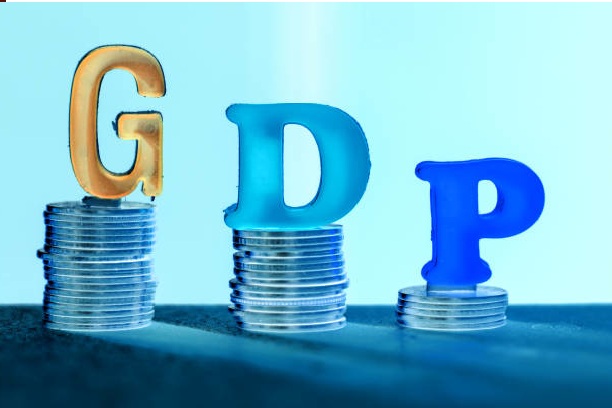🌍 Understanding Gross Domestic Product (GDP): The Pulse of a Nation’s Economy
Introduction
When you hear phrases like “the economy grew by 6%” or “the country is heading toward a recession,” what’s really being measured is the Gross Domestic Product — or GDP. This single number summarizes the overall economic performance of a country. It’s one of the most vital tools for policymakers, businesses, and citizens to understand economic trends.
But what exactly is GDP, how is it calculated, and what does it tell us? Let’s dive deep.
💡 What is Gross Domestic Product (GDP)?
Definition:
Gross Domestic Product (GDP) is the total monetary value of all final goods and services produced within a country’s borders in a specific time period, typically measured quarterly or annually.
This includes everything — from the cars manufactured in factories to the coffee you buy at a café — as long as it’s produced within the country and in the given time frame.
Key Concepts in the Definition:
-
“Final goods and services”: Only finished products are counted — not intermediate goods used in production (to avoid double-counting).
-
“Produced within a country”: GDP includes production by both domestic and foreign companies as long as the activity occurs inside the country.
-
“Monetary value”: All goods and services are valued using market prices to give a standardized measurement.
🧮 How is GDP Calculated?
There are three primary methods to calculate GDP — and all should theoretically yield the same number:
-
Expenditure Approach (most common):
GDP=C+I+G+(X−M)\text{GDP} = C + I + G + (X – M)
-
C: Consumption (household spending)
-
I: Investment (business investments, construction)
-
G: Government spending
-
X: Exports
-
M: Imports
-
-
Income Approach:
-
Adds all incomes earned by individuals and businesses in an economy (wages, profits, rents).
-
-
Production (Output) Approach:
-
Measures total output minus intermediate consumption.
-
📊 Types of GDP
-
Nominal GDP:
-
Calculated using current market prices.
-
Includes effects of inflation or deflation.
-
-
Real GDP:
-
Adjusted for inflation to reflect the true value of goods and services.
-
More accurate for comparing economic performance over time.
-
-
GDP per Capita:
-
GDP divided by the population.
-
Useful for comparing living standards between countries or across time.
-
🧩 Components of GDP Explained
1. Consumption (C):
-
Spending by households on durable goods (cars, furniture), nondurable goods (food, clothes), and services (healthcare, education).
2. Investment (I):
-
Spending on new capital (machinery, buildings).
-
Includes residential construction and inventory changes.
3. Government Spending (G):
-
Expenditures by government on goods and services (infrastructure, defense, public services).
-
Excludes transfer payments like pensions and unemployment benefits.
4. Net Exports (X – M):
-
Exports (X): Goods/services sold to other countries.
-
Imports (M): Goods/services bought from abroad.
-
If exports > imports = trade surplus (positive effect on GDP).
-
If imports > exports = trade deficit (negative effect on GDP).
🔍 Why is GDP So Important?
✅ Indicator of Economic Health:
-
Rising GDP indicates a growing economy.
-
Falling GDP signals economic decline or recession.
✅ Basis for Economic Policy:
-
Central banks and governments use GDP data to set interest rates, tax policies, and spending programs.
✅ Attracts Investment:
-
Countries with high and stable GDP growth attract foreign and domestic investment.
✅ Standard of Living Insight:
-
GDP per capita is often used to estimate average income and quality of life.
⚠️ Limitations of GDP
While GDP is a powerful metric, it has limitations:
-
Doesn’t measure income inequality: A rising GDP may benefit only a small section of society.
-
Ignores environmental costs: Destruction of natural resources may increase GDP in the short term but harm sustainability.
-
Overlooks unpaid work: Household labor and volunteer services aren’t counted.
-
Doesn’t assess happiness or well-being: A country may have a high GDP but low life satisfaction or poor health indicators.
🌐 GDP in the Global Context
In the global economy:
-
USA has the highest nominal GDP.
-
China is growing rapidly in real GDP terms.
-
India, with its digital transformation and service-led growth, is expected to be among the top economies in the coming decade.
Global institutions like the IMF, World Bank, and OECD track GDP trends to make projections and guide international financial policies.
✅ Conclusion
GDP is like the heartbeat of an economy — a single measure that reflects the rhythm of production, consumption, and growth. While it’s not a perfect tool, it offers critical insights into a nation’s economic activity, helping guide decisions at every level — from policymakers to investors to everyday citizens.
Understanding GDP empowers us to see beyond the headlines and grasp the real story behind economic trends.

